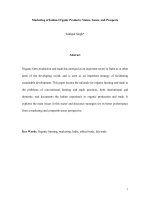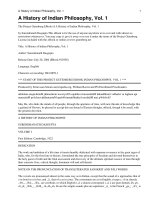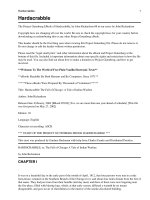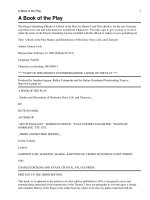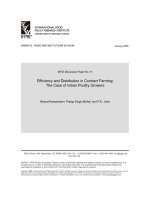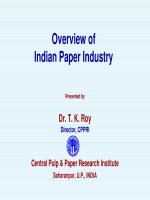Illustrations of Indian Ornithology, Jerdon 1847
Bạn đang xem bản rút gọn của tài liệu. Xem và tải ngay bản đầy đủ của tài liệu tại đây (9.39 MB, 241 trang )
ILLUSTRATIONS
INDIAN ORNITHOLOGY,
CONTAINING
iriFiT ifE©wmi
OP
NEW, UNFIGUEED AND INTERESTING SPECIES OP BIEDS,
CHIEFLY FROM THE SOUTH OF INDIA.
BY
T.
C.
JERDON, ESQ.
MADRAS MEDICAL ESTABIISHMEST.
MADRAS:
PRINTED BY
P. R.
HUNT, AMERICAN MISSION PRESS.
1847.
^y
INTRODUCTION.
work
is
with
to
a
conclusion,
Forty-seven
The
either
great
majority
of the
though
or
are
Three
—
all
are
figured
different
drawings.
and one from Ceylon
long
so
of Birds
of them
figures,
that
satisfaction
species
distinct
improved
remainder
layas,
much
It
the
represented
here
of the
of
in
the
are
the
this
obstacles.
fifty
plates.
time,
and
compose
the
first
plumage,
birds
inhabit
various
the
for
brought
has
by
delayed
states
rest
Author
the
from
the
peninsula
of
HimaIndia.
CONTENTS.
Plate
1.
Nisaetus Bonelli.
Plate 26.
Bucco
Viridis.
2.
Leucocirca Albofrontata.
27. Buteo Rufiventer.
3.
Zanclostomus
28. Falco Peregrinator.
Viridirostris,
4. Accipiter Besra.
29. Accipiter Besra.
5.
Picus Hodgsonii.
30. Strix Candidus.
6.
Prinia Cursitans.
31.
7.
Muscipeta Paradisea.
32. Muscicapula Sapphira.
8.
Turdus Wardii.
33. Otis Aurita.
9.
Scolopax Nemoiicola.
34.
10. Pterocles Quadricinctus.
11. Phfenicornis
12.
Flammeus.
Falco Peregrinator.
13. Crateropus Delesserti.
14.
Muscicapa Albicaudata.
15. Oriolus Indicus.
16.
Ardea
Flavicollis.
Brachypus Poioicephalus.
Anas Caryophyllacea.
35. Pycnonotus Xantholasnius.
36. Pterocles Quadricinctus.
37. Brachypus Rubineus.
38. Mirafra Erythroptera.
39. Dicaeum Concolor.
40. Picus Cordatus.
41. Scops Sunia.
17. Lanius Nigriceps.
42. Francolinus Benulasa.
IS. Pateornis
43. Phyllornis Jerdoni.
Columboides.
19. Malacocircus Griseus.
20. Petrocincla
21.
Pandoo.
Vinago Bicincta.
22. Pastor Blythii.
44. Falco Luggur.
45. Anthus Similis.
46. Parus Nuchalis.
47. Picus Ceylonus.
Dendrocygna Major.
48.
Columba
24. Caprimulgus Indicus.
49.
Xiphoramphus
23.
25.
Ceyx
Tridactyla.
Elphinstonii.
Superciliaris.
50. Indicator Xantlionotus.
INTRODUCTORY NOTICE.
The
at lengtli
was led
fii-st
part of the
ILLUSTRATIONS OF INDIAN ORNITHOLOGY
presented to the Public, after a greater delay in the publication than the Author
to expect.
The ground-TTork and branches
Artist,
and the Author here begs leave
very valuable
the work.
aid,
are from the pencil of a highly talented amateur
to
tender his most grateful acknowledgments for his
which has contributed not a
little
to set off the
Several of the plates, however, viz. Nos.,
off before the
1,
2, 3, 4, 5,
Author became acquainted with that gentleman.
those
Officer
first
added a ground-work
The
to these.
printed similar to that of the
colourists
drawings and embellish
6 and 12 were printed
Thirty additional copies of
these plates being afterwards found necessary to meet the increasing
same
is
of Subscribers, the
list
were instructed
additional lithographs
;
but, as
to
paint in to
might have been
expected, they have not executed this part so well as the Author could have wished, and they
were not allowed
to finish
in some than others,
all
wiU be found among
explanation may prove sufficient to those
The 2d No. being
distant interval,
In consequence of
the copies.
the plates mentioned above
who have the
entirely printed
and the nature of
its
this a difference,
and
contents
;
and I
more marked
trust that this
opportunity of comparing the two
partially coloui-ed, will
wiU probably make
it
more
sets.
appear at no very
attractive
than the
present number.
Should the publication of the present
series of fifty
bu'ds be, as there
is
every
reason to anticipate, successful enough to repay the Author for the heavy expenses he has
incurred,
it
and the two
wiU, immediately on completion, be followed by a second set of fifty more bhds,
series will
then include a very considerable number of the unfigm-ed species
of Peninsular India.
A classified Index will be given
corrections of nomenclature that
Nelloke
:
may be
with the concluding No. which will notice any
required.
November 3d, 1843.
'Af'j-aeJjM)
^^^je/ru,ot/^
J'.wUtJ- iy
^..':jii-''!^-atM/-
ORB. KAPTORES.
TRIBE— FALCON IBM.
FAM. AQUILINE.
GENUS N I S ^ T U S—Hodgson.
PLATE
NIS^TUS
I.
GRANDIS'-Hodgson.
YOUNG FEMALE.
LARGE HAWK-EAGLE.
Synon.
Niscetus niveus,
Jerdon
—Madras Journal of
Sahua, in Teloogoo
Mhoriinghee, in Hindustani
The group
by Mr. Hodgson,
high
is
tail
there characterized
by compression without
large, vertical, elliptic, angulated
—
and wholly
long, firm and square
digits elongated, nervous, the inner fore
late
—
as
follows
feebleness,
first
separated
:
— " BiU
short,
tarsi elevate,
fifth
but not feeble, wholly feathered
—acropodia
talons
base
strongly festooned, nares
and the hind highly developed
—
at
esposiire— wings short, finn,
lateral in
with three or four scales next each talon
acute
Rajalee, in Tamool.
6th volume of the Journal of the Asiatic
iu a paper published in the
as broad, distinguished
quiU longest
and Science, No. 24.
of rapacious birds to wMcli tUs fine Eagle belongs, was
Society of Bengal, and the genus
as
Literatui-e
reticu-
immense, very unequal, strong and
—head usually crested."—Mr. Blyth, the zealous and able
Curator of the
Museum
of
the Asiatic Society at Calcutta seems to thiak that this genus is not separable fi-om Spizmtus
of authors.
Not having had an opportunity
American Eagles
it
likely there
classed in that genus, I cannot attempt
wQl be found some shades of
peric distinction.
of examining any of the African
This I consider
to
to decide the
point, but I think
difference, warranting at all events
be the more likely as the genus
A
is
and South
a sub-ge-
not one of universal
HUistrations of Indian
Moreover, Swainson
occurrence.
member
of
separated
Falco cristatellus, an undoubted
the
group, from the African crested Eagles, retaining however Spizafiix for
tliis
Indian Bird, and classing the others under the genus Ilarpi/ia.
tlie
me
in a letter to
this,
and
name
as
waiting of the present subject says
Sii'
W.
Jardine too
modified characters will receive both
'
present retaining Hodgson's excellent
being more appropriate to the habits as well as structure of the birds of
SpizcBtus.
a synonjin of Limnatus.
described as having
The
Hodgson
prefer for the
I therefore
cristatellus.'
group than the name
as
has
Ornithology ;
all
—Mr. G. R.
This
is
Gray, in his Genera of Birds has put Kisivfus
of coui'se a grievous
Hawk-Eagle was
first
this latter
described and
volume of the Journal of the Asiatic Society.
Catalogue of Peninsular Bu-ds in the Madras Journal,
and referred
error,
genus being
the claws nearly equal and small.
present species or large
in the 5th
tliis
this bird to the
in the books of reference I
I
When
named
I
])y
Mr.
drew up the
was unawai-e of Hodgson's paper,
Falco niveus of authors, with the meagre descriptions of which
had
access to,
it
indeed sufficiently agrees.
I
have however since
be
distinct.*
I shall now give a description of the species represented here
taken partly fi-om
my own
observations, and
ascertained
it
to
partly from the obliging communications of
Mr. Blyth.
Young
bird.
somewhat darker.
deeply stained
—Plumage
above pale broAvn with the shaft and
Beneath, imder wing-coverts and
"ndth ferruginous)
feathers, almost obsolete in
some.
tibial
plumes of
tip
of each feather
a rusty white (in
some
with a very narrow mesial pale brown stripe on the
—Tail
above closely and numerously barred with brown,
on a pale brown ground.
Adult.
—Above deep
aquiline or
wood
bro'ma.
Beneath, pure white with a dark
brown mesial
line to
on the
on which in old birds the brown hue predominates, and takes the form of
bars.
belly,
each feather
;
broader in general in the female, and most developed
Under wing-coverts dark brown
plumes deep brown, freckled whitish
—
—under
tail
tail-coverts
white banded brown
hoary grey with seven
bai-s
—
tibial
and a broad subter-
minal one.
An intermediate
•
The name
state of
plumage
is
marked by
Strenuus, was printed on the Plate before
I
the
pale edging to the feathers
was aware that the specimeD from which
the drawing was taken was identical ia species with grandis.
DSI
Niscettis grandis.
by the
of the back,
development of the mesial markings of the feathers of the lower
less
plumage, and by the paler
At
in some)
all
and their bases are conspicuously white.
27 inches
to
—tail 12i
—
irides bright
—wing from
S^V
digit
flexiu-e
17|
claw
^'^-
gamboge
to
Himalayas
margined with whitish
plumbeous, black
Bill
Dimensions
yellow.
18 inches
—
11
tail
—
to
large
Hawk-Eagle
is
at tip
to
said to be an
and
a male
gape 2
—wing 20^
It is
much on
by
abimdant species, though few
a pair of them.
the wing, sailing at a great height; and
it
It
seated on the siunmit of a lofty tree, or on some overhanging rock.
and mountain
hills
making
same hour.
always about the
frequents
its
appearance at
may
in the bare
Deccan and
drawing was taken was killed in Guindy park
It preys
by preference on
various
and partridges, and even on pea fowl
—
according to the testimony of Sliikarees
J
talus leucocephalus
.
On
hawk.
off a favorite
Most
The
Carnatic.
also
it
at
kuids of game
—hares,
on ducks, herons and other water fowl, and
known
to strike
one occasion on the Neilgherries, I observed
down
it
the douk,
its
ness of the jungle.
A pair were
to resort to a village
at the
f Tan-
having carried
stoop
and pea-fowl, each time unsuccessfully however, owing
Elliot too mentions
though
jungle fowl, spur fowl
at a spiu"-fowl, hare,
Mr.
also
Madras.
has been
wont
;
it
individual fi;om which the present
native Falconers too have stories to relate of
also
often be seen
I have observed
on the Neilgherries, along the range of western and northern ghauts
more sparingly
dis-
It chiefly affects the
and especially the neighboiu-hood of
districts,
certain spots in the district
fowls.
—cere
—Length of
30 inches
brown
dispersed over the whole continent of India from the
Cape Comoriu, but cannot be
more wooded and jungly
chiefly
(or pale
bill straight to
Length of female 29
1-^^,,.
are not occasionally frequented or visited
ranges.
are
plumes.
to 13.
The
tricts
yeUow
3|— centre
tarstis
tarsal
of the nape
ages the feathers
feet pale greenish
26
and
tint of the tibial
liHls
successively
to the
thick-
and carry
off
" that he once saw a pair of them nearly surprise a pea-
cock, pouncing on hiui on the ground."
Great havoc was connnitted among several pigeon-
houses on the Neilgherries by a pair of these Eagles, and indeed I heard that one or tn^o
were completely devastated by them.
described to
me by
two or
thi'ee
The manner
fi-oni
a vast height on the
rather under the pigeons, than directly at them.
and
carries
it
first
off.
swoop the pigeons
The
which they captured the pigeons was
eye witnesses to be as follows
one of the Eagles pounced down
alarmed by the
in
Its
rise in confusion,
other Eagle having risen again
:
—On the pigeons taking
flock,
but directing
its
flight,
swoop
mate watching the moment wheCj
pounces unerringly on one of them
eilso
makes another stoop which
is
Illustrat'totis
generally
One
fatal.
of these birds shot in the act was presented to
H ho had been a great
sufferer
by them.
the nest of this Hawk-Eaglo, but
inaccessible
cliffs,
The
and
other
it
—
I
have not yet been fortunate enough
by native
said
is
Sliikarcos to build
3rd,
N.
species of this
Kieieriin
;
—and
group are
N.
4th,
has been merely indicated by Hodgson as N. pallidus.
tion of these four species
1st.
Syn.
Tern.
F.
—Above brown, the
developed occipital
meet with
on steep and
1st,
Niseetvs niveus.
A
fifth
—~d,
species
here give a brief descrip-
me by Mr.
Blyth.
I
Hodgson.
Nipalensis,
feathers with broad pale edgings, usually has a slightly
—beneath white, nearly
ed with pale fulvous bands —under taU-coverts
spotless
—
tibial
plumes white, regularly cross-
^^-hite sj)otted ^-ith
with dark mesial
Intermediate age
stripes,
—Above dark
brown with
stripe do^^^l the throat
tibial feathers
pkime
tail
bro^^-n
on the
and 2 lateral ones
—
rest of tlie
plumage be-
feathers barred with dark bro-wTi
young
as in the
bii'd.
dusky black, dashed with ashy on the back
surface of the primaries anterior to theu-
five
blackish.
aquiline brown, with pale edgings, obsolete
bro^\nisli
—Plumage entirely
tail
quills
a
Adidt
—
distinct,
—beneath white with dark mesial
defined—breast with
black drops on each
neath nearly
dark brown —
and under
and white —tad
with an ashy tinge and banded
interscapidars
broMTi
—the tipwhitish—head and nape
extending by age —
barred with
dark bands and a subterminal one broader and more
all
to
sometimes found possessed of a long drooping occipital egret-Hke
crest,
less
—
cristatellus.
— Nis.
Raffles
caligattis,
crest of two long feathers
usiially light fulvous
a gentleman,
SUBCRESTED HaWK-EaGLE.
NIVEUS
NiS-ffiTUS
:
I shall
from copious information afforded
Falco niccus,
Young.
me by
breed in January or February.
to
known Indian
N. pzilcher, Hodgson.
of Indian Ornitltohgy
—the under
emargination and the xmder surface of the
tail
—caudal bands only
—
grey
beneath— cere dark
brown
yoimg—bright yellow
Length of a male about
adidt —
pale wax yellow.
25 inches —expanse of wings 49—wing 15 —
11 —
1| —
Female
3
from 26
29| inches —exi)anse54—wing 15f—
11 —
\l—
alone albescent
in
livid
visible
in
This species has a larger
bill
tail
known
light
feet
tail
to
irides
at
gajje
^bill
tarsus
J.
tarsus 4.
geographical distribution than any other of th«
genus having been found in Bengal, the Himalayas, and Java.
Niscetus grandis.
NlS^TUS
2ud.
Above deep
—
long
feathej's
bro'UTi, blackish
PTJLCHEEj
ou the
Hodgsoii.
and
cro-s^Ti
of the nape pale at base and edges
which
occipital crest
—beneath
is
4 inches
tmged with fulvous
-white,
ones
blackish—breast
and two
broad
—central of
longitudinal streaks —belly and flanks banded and mottled bro-mi and white — under
banded—
plumes
—upper
coverts
plumes
coverts the same —
on a
grey ground. Length
banded—
mth 5 dark broad
and
Female 33—wing 19 —
of mak £9 inches —^wing 18 —
14J.
chin blackish
lateral
tlrroat
line
also
ivith
tail
tarsal
distinctly
tibial
q^uiUs also
tail 13.
tail
3rd.^-NisjETUs Kienieeii, Red-bodied
De
Astur Kiemerii,
Syn.
Sparre
tail
bro-svnish
bai's
tail
so
less
—Guerin
Mag. de
Hawk-Eagle.
Zoologie, 1835.
Nis.
aliogularis,
Tickell— Jour. As. Society, 1842.
Above black
Avith a
shade of brown
—an
occipital
2 J inches long
crest
ueck, and breast, 'pure white, the sides of the last only with black streaks
under
tail coverts,
—
tail broivii,
eaj'
iu
its
—
^wings.
The spechnen
second or third year
each feather streaked with black
;
fi-oni
which
this description Avas
the younger bird as shoAvn
by De Sparre
as
quoted above.
flanks,
—throat
wliite
— cheeks
—
^irides
dark
feathers
had the
apparently more advanced stage
Pkunage above and
with copper reflections, most apparent on the wings
with clear rufous
belly,
taken was probably
by some unmoulted
An
broAvn of the upper plumage only moderately dark.
described
—
thi-oat,
and tad beneath albescent, with narrow bands—
at base, the rest rufous,
M'ax yellow.
—
under surface of wings deep rufous, streaked with black on flanks
obscurely banded
coverts white
— cere
legs,
,
_
— secondaries
is
occipital crest, fine black,
and ridge of wing edged
mixed with white black and red
—neck and breast
white with longitudinal medial black spots, most numerous and largest on the breast and
these
mixed with rufous
—
—under
spots
and large black medial spots
^belly,
abdomen and
sides rufous,
marked with nuinerous
tad coverts and legs unspotted rufous
above, albescent beneath with black band.
Length 22 inches
—wing 16 —
tail
—
10
tail
black
—biU If
tarsus 3.
A single specimen was
India.
is
procuxed by Lieutenant Tickell
The specimen described by De Sparre was
in the collection of Prince Essling.
B
at
Chyebassa in Central
said to be from the Himalayas and
Illustrations
4th.
—Nis^TUS CRISTATELLUS,
Elliot
Syn.
from
Judging
young
the
ly
analogy
of this
ycUowish
and nape
narrow black
and
Jotunal of Literature and Science, No. 25.
species of this genus
other
witli
bird
margins
pale
by
described
tluH
is
Beneath,
wliite tip.
what
apparent-
is
Above and
Jardine.
occi-
each feather, forehead white, head
to
mixed with amber brown.
browTi,
bars,
—Madias
Falco. cristatellus, Tern.
amber brown with
crest
pital
state
of Indian Ornithology ;
Tidl above bro\m, Avith seven
of
feathers
tarsi,
and
ridge
of
the
wings white.
Apparently the second plumage
Above
bro^A-n tinted
is
with rnfous
thus described by Lesson.
—head
and neck rufous streaked
bro'wn,
•with
beneath wliite streaked with bright rufous, deejiening in the flanks, inferior coverts and
Tail brownish rayed with dark brown.
legs.
A
stUl
more advanced age (Mr.
deep brown, the
occipital crest, fine
nearly black, quills banded with dark b^o^vn.
Beneath white, each feather with a large blackish brown drop, which
Tail with five bands.
occujiies nearly the
latter
specimen) has the plumage above and
Elliot's
whole feather, flanks and lower part of abdomen nearly
all
brown.
Tarsal feathers of a fawn tinge, spotted with brown.
Cere and
—
ll/o
tail
bill to
orbits
dark livid or plumbeous. Length, of male 24 inches
gape Ixo
—
tarsus 4.
The specimen described by Jardine was
M.
England.
Lesson's specimen
foot of the Eastern
In
it is
N.
71
comparmg
impossible
the same
about
each
Ghauts inland from Nellore.
had taken of
that gentleman
is
and
to
only
differ
Elliot's
may add
was procured
that the description
at the
of this
and partly from a drawing which
Elliot's,
bird
of this
with those
of Nistctus
avoid the sujiposition that they are identical.
relative:
The
dimensions.
from that of
should expect in a bird of one
It is represented very short in
and
have been taken on the coast of
specimen.
the descriptions
I think
size
liis
I
nearly identical, and the more advanced
i feus
Ulceus,
said to
was from Ceylon, and Mr.
specimen has lieon taken partly from ^Ir.
latter
—wing IG —
less
Mr.
Mr.
Elliot's
moult.
Elliot's
The
description of the
state
as
specimen
described by
in
cere of both
is
such a
They
young
l\Ir.
nioeus,
state of
Blyth
degree,
arc
as
described as being
of
we
livid.
drawing thus further corresponding with
lastly the geographical distribution of niveus
being comparatively so extensive.
Niscetus grandis.
we have
every reason to expect
its
occTu-rence in Soutliem India.
I
may
here state that
I observed a bird apparently of this species in higli jungle at the foot of the Neilgherries.
It
was seated on the summit of a high
tunately unable to procure
tree
and had
its
crest raised.
I was xmfor-
it.
In a future part of
plumage of Niscetus grandis.
this publication I
hope
to
be able
to give a figure of
the adult
n
^,^cfccc^zcu
M^/^-a^^^^
Bu*^*W^y
-t^^^iS^MGn^ij^oic-
ORB. INSESSORES,
TRIBE— DENTIROSTRES.
FAIL
31
US CI C API D^.
GEN. LEUCOCIRCA.
PLATE
11.
LE UCO cm CA ALB OFR ONTA TA.
WHITE- BROWED FANTAIL.
—Proc.
Blnpidura albofrontata, Franklin
Synon.
Zool. Soc. 1831^ page 116.
Mucliurrea, Hindustani.
In
tlie
genus was
Library, tbis
distinctions being the
towards the
loped.
tip,
its
The
bill
the
It appears
India and
volxune
excellent
first
on Flycatchers by
proposed
to
be separated
broader
more lengthened,
bristles
not
restricted to
quite
the
Swainson,
so
long,
tropics
from Rhipidura
at the base,
and
and the legs and
of the
the Naturalist's
in
more
feet
cbief
compressed
less
world, more
old
the
;
deve-
especially to
Islands.
subject of our present plate was
usefid Catalogue of Birds procured by
him on
first
described
by Major Franklin,
in his
the banks of the Ganges and the Vindhiau
range of mountaius, which was published in the Proceedings of the Zoological Society for
1831.
It
pubhshed
was
also
in the
iacluded by Colonel Sykes ia his Catalogue of the Birds of the Diikhun,
same work, and I gave a brief account of
its
habits in
my
Catalogue of
Birds of the Peninsula of India, published in the Madras Journal of Literature and Science.
It
would accordingly appear
of India, though
it
to
have a tolerably extensive distribution over the continent
has not been found in Bengal,
its
place there being
taken by the
Rhipidura fuscoventris of Franklin, which I have not yet observed in the
Peninsula,
Illustrations
though
it
is
included in Colonel Sykes'
ITliite-browed Fantail
and
only found at
is
aware, in the
dcjitlis
Towards the South of the Peninsula, the
list.
common
all
of frequent occurrence all along the
it is
the
of Indian Ornithology ;
in those
Western
districts
In the bare Carnatic,
some of the patches of low jungle found in the more
clump of
it is
Itself
N. Lat. 20°,
it is
more sparingly
in
Towards
had an opportunity of observing
as I
much more common and
still
diffused,
and may be seen
in every
trees or garden.
its
habits
flitting
now and
am
now and
only met with
portions of this district.
liilly
Northern part of the Peninsula however,
In
tmually
wood,
though not found, that I
coast,
then in large topes or groves of trees, and extensive gardens, and
at Jaulnah,
in
of the forests, preferring chiefly avenues of large trees, gardens, and
more open portions of the jungle.
the more
abounding
it
appears to be the most active and restless of the whole family, con-
about from branch to branch, snapping up an insect on the wing every
then, and raising
on a twig.
It
its
outspread
hardly ever
tail,
and lowering
beyond a few
flies
wings, whenever
its
it
reseats
an insect, and seldom
feet after
re-
turns to the same perch, traversing in succession most of the branches of the tree, and not
resting during even the heat of the day.
or three in company.
occasions observed
perch.
its
Its
I have usually seen
I have several times seen
it
it
solitary,
on the ground, and on one or two
alight
seated on the back of a cow, and pursuing insects from this unusual
it
whence
chief food consists of mosquitoes and other small dipterous insects,
Hindustani name.
It has
a pleasing little song,
which
it
warbles forth every
now and
of several notes following each other in a regiilarly descending scale.
ing togetherof this bird, and L. fuscoventris, says, "
spreads and raises his
name
in
Teloogoo
is
tail
of the Hindoos
The male
Dasharee
pitta, a
name
adorn their foreheads.
I
time I believe.
I shall
bough."
for the white stripe,
was inibrmed that
in this coimtry raising their clothes high above their heads
its
Colonel Sykes speak-
He
Its
popular
wliich refers to the conspicuous white forehead
its
Manatee, or Washertnan, given from the continual upraising of
ignorant of any facts as to
then, consisting
has a very sweet note.
over his head in hopping from bough to
and eyebrows, Dasharee being the Teloogoo name
am
occasionally two
nidification.
The
it,
name
its tail,
in
Malayalum
the
is
and
figured here for
a synopsis
is
washermen
and beating them on a
species
add a brief description of
with which certain
stone.
the
of the
I
first
other
Indian species.
Description.
—Plumage above
and neck in
front,
dusky black, darkest on head and
Leucocirca albofrontata.
neck, and palest on the
wing
a few spots on the
white
^length
T°o
—
at
and Sykes
other ascertamed Indian species of
—
at
—
throat white
tail
—
irides
gape
-^-a
dark bro^ni
group are
tlais
as follows
:
of Franklin, Proc. Zool. Soc. 1831,
all,
Description
species.
—band across the
-
iinder tail
—
^length
—
my
Catalogue of Birds previoiisly referred
had observed
that species
—
bill
tarsus t\
and legs
— bill at
front
on the Neilgherries, though I had not pro-
I have accordingly characterized
valleys at the edges of woods,
the same as those of
3.
otV
—
its
mention under the head of L.
to, I
Since that time I obtained this bird and found
it.
tail
chin
tinged with fulvous-
whitish,
ones, tipped lighter
6J inches—whig 3
cheeks black
breast black white spotted,
coverts
except the centre
—head and
—weight 6^ drachms.
undescribed, so
much
—New
—^abdomen and
light dusky,
fuscoventris, that I
warmer
legs
bill
jRhipidiira fuscoventris
plumage above dusky black
In
cured
—
L. pectoralis, Jerdon
feathers of the
jV
(except the two centre ones)
—mentioned above.
2.
blackish
tips of the tail feathers
plumage beneath,
tail
^tarsusr^o
L. fuscoventris
1.
blackish
and the
to the nape,
at
The
—rest of
coverts,
eyebrows extending
throat white mottled with black
firont
.
forelieadj
—hides dark brown— and blackish
gape
about 7 inches or 7 J — extent of wiags 10 —wiag from flexure Sto — hiU
about tV —
— S/o —^weight 6| drachms.
—chin and
—
—
tail
it as
it
to
be
above.
and occasionally hedges and
distinct
and apparently
It fi-equents
thickets.
cMefly the
Its habits are
congeners.
L. liypoxantlia, Blyth,
Description.
brihiant-yellow
—Above of the usual dusky
—
coloru*
—eyestreak, and
enthe under parts
conspicuously white shafted with white iaterior edges to the feathers
^taH
—length 4J inches.
for their terminal half
Hab. DarjeeHng.
